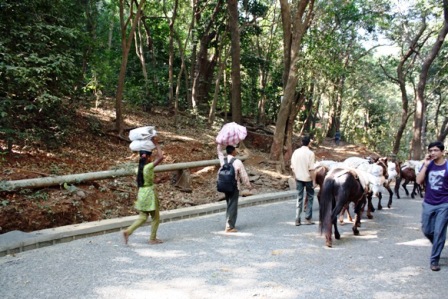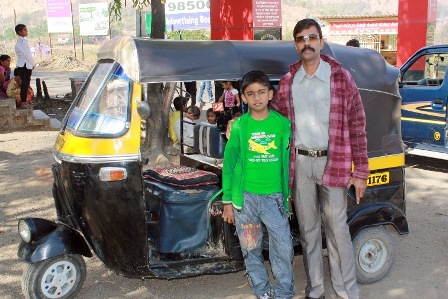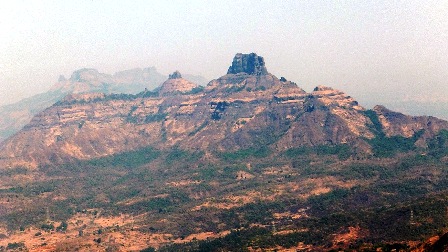Southern India Revisited
Episode 8: Journey to Matheran
 |
Previous: Episode 7: Benaulime Next: Episode 9: Matheran Hillstation
|
February 23-24 2013 Matheran
Who said the trains in India are
now on schedule? They didn’t travel with Ray and me. We had it all
figured out how to get to Matheran, the smallest hill station in
India. Our first choice of trains from Margao to Mumbai was an
overnight train with comfy AC berths. From Mumbai it was to be a
short trip on a local train to Neral, the station at the base of the
mountain with the town of Matheran on top. Then a 3 hour ride on the
scenic Matheran mini-train would bring us right into town. It
sounded so easy. It was not easy.
First of all there were no berths available on either of the two overnight trains. Plan B was put in motion. We booked seats in the sleeper car for the day train that would reach Panvel, a southern suburb of Mumbai, at 7:15 PM. That meant an overnight stay in Panvel but there was a nice sounding hotel near the train station that promised to pick us up from the train. Our rickshaw driver was right on time to take us from the Royal Goan to the train station in Margao, the closest station to the southern Goa beaches, and we easily found our seats in the sleeper car. The sleeper car is “naturally air cooled”, i.e. the windows open, and there were ceiling fans. The six occupants of each compartment share seats on what would be the lower berth with backrests that become the second tier berth during the night. The third tier berth is then available for extra luggage that doesn’t fit under the lower berth or for naps by anyone wanting to stretch out. There were two other tourists, a father and his teen aged daughter from Poland, already in our compartment and we were soon joined by a young Czech couple. We started our train ride from Margao exactly at 9:30 AM, as advertised. From that point on we were at the mercy of every other train traveling between Goa and Mumbai or Delhi. We did enjoy talking to our compartment mates and we were never at a loss for food. There was always someone coming through the car selling samosas, sandwiches, vegetable or chicken biriyani, soft drinks, water, you name it, and the prices were very reasonable. About two hours into our trip we stopped at a station for a brief stay that stretched into one hour. While sitting on a siding we were passed by a speeding express heading south and finally, another express heading north to Delhi that had left Margao after us, passed our train. We started off again only to catch up with the Delhi Express and this time both trains sat waiting. We knew there was no chance of keeping to the schedule. No explanation was ever given for the delay. Train travel in India means being very patient. Ray had chatted to some of the Indian passengers on our car who promised to make sure we got off at the right stop. They were more than helpful. They phoned our hotel for us to tell them the train was delayed, not once but three times. Finally we arrived at Panvel at 9 PM. A woman employee of the hotel was waiting for us on the platform with her husband, a rickshaw driver, and her 10 year old son. They had been waiting for us since 7 PM. We made arrangements for the rickshaw driver to pick us up the next morning for the next leg on our trip, checked in, and said good night.
The taxi ride would have been a
very short ride if we hadn’t asked the driver to please slow down as
he took the sharp turns at race driver speed straight up the side of
the mountain. Slowing down also prevented the two of us from getting
car sick.
 hire a porter to carry your luggage on their head I misunderstood the travel directions in our Lonely Planet guide book, for I was under the impression the taxi could take us to a car park that was only a short walk to the town of Matheran. There are no cars in town so the choice is to walk with your luggage, walk and send your luggage via a porter, ride a horse or be carried up in a litter chair that required two men, one to pull and the other to push up the steep sections. We like to walk and our wheelie bags are usually easy to pull. It actually would have been a pleasant walk except that we had to fight off very persistent entreaties from touts offering their services. It wasn’t until we reached the edge of town that we were able to walk in peace. We also hadn’t factored in the 3 km of dusty red dirt road, made worse by the dust kicked up by the horses and the sections strewn with rocks. We did make it by ourselves and we found our hotel, which turned out to be a good choice. Once was enough on that dusty road. We plan to take the mini-train down when we leave.
|
Previous: Episode 7: Benaulim Next: Episode 9: Matheran
Read Sri Lanka 2013
Return to India 2013 Intro
Return to India Chronicles 2000-2001
Return to Travels
or Introduction

